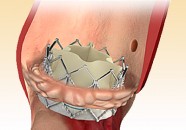Mitral annulus calcification (MAC) affects between 8% and 23% of the population. It is more common in women and patients with renal insufficiency. This phenomenon is characterized by an increase in valvular annulus fibrosis, which can extend and affect the leaflets. The presence of MAC is associated with valve regurgitation or stenosis, increasing mortality and…
Edge-to-Edge Repair for Right Ventricular Function Deterioration
Tricuspid regurgitation (TR) has been associated with worse survival and hospitalization for cardiac failure (CF). The current guidelines recommend surgery as treatment, despite its 8 – 15% 30-day mortality rate. And there is no mention of a transcatheter intervention, especially for patients with severe TR and right ventricular deterioration. Several percutaneous intervention devices have recently…
Evolution of Cardiac Damage in MitraClip
Degenerative mitral valve regurgitation affects the mitral apparatus and is related to severe insufficiency. At present, surgery is the treatment of choice for patients at low risk. Oftentimes, this disease affects the elderly and/or those at high surgical risk, edge-to-edge repair being an excellent treatment alternative. We all know that the different stages of ventricular…
Cardioband in Tricuspid Valve Regurgitation
Untreated tricuspid regurgitation (TR) has been associated to high morbimortality. Surgical treatment of isolated severe TR is complex and carries a high mortality rate. A transcatheter treatment of this valve is currently being developed, and different concepts are being applied to the new devices. Even though most TR is secondary, atrial functional tricuspid regurgitation (A-FTR)…
2 Year Outcomes of Transcatheter Mitral Valve Replacement with Intrepid
Severe mitral valve insufficiency (MI) has been associated to the progressive deterioration of left ventricular function, cardiac and kidney failure, and increased mortality. Complete medical treatment at maximal doses and surgery are indicated. For those at high risk or those with ventricular function deterioration, edge-to-edge repair has been shown an excellent alternative. The use of…
QFR Analysis of Coronary Lesions with TAVR
While transcatheter aortic valve replacement (TAVR) has shown benefits, significant coronary artery disease affects 50% or more of patients who undergo such procedure. However, it is still unclear which is the best treatment strategy or how to handle this condition. Quantitative flow ratio (QFR) could be a non-invasive option to assess the severity of coronary…
TAVI in Horizontal Aorta: Neo2 vs. Sapien Ultra
There are controversies regarding transcatheter aortic valve implantation (TAVI) in cases of challenging anatomical complexity, such as horizontal aorta (HA). This is primarily because aortic angulation (AA) impacts the procedure differently depending on the valve type used. As previously studied, angulation complicates crossing, implantation, and coaxial positioning with commissural alignment. In the study presented by…
High Gradients After Valve-in-Valve
One of the limitations of aortic bioprostheses is their durability. When these devices fail, percutaneous valve implantation is a valid strategy. However, it has been shown that there may be high gradients involved. This gradient increase has been associated with worse outcomes and higher mortality rates, as observed in the PARTNER 2 study at 12 months.…
Low-Flow Aortic Stenosis: What is the Value of Valve Calcification in its Interpretation?
Delays in the treatment of symptomatic aortic stenosis (AS) reduce prognosis, especially in elderly patients. Accurate assessment of AS severity is crucial to avoid overtreatment and its associated risks. A transthoracic echocardiogram (TTE) is the initial evaluation in the diagnostic algorithm, and severity values are well established. However, some patients may obtain discordant data due…
TAVR vs SAVR in Los Risk Patients: 10-Year Outcomes of the NOTION Trial
Transcatheter aortic valve replacement (TAVR) has revolutionized the treatment of patients with severe aortic stenosis (AS). Randomized studies have shown the benefits of TAVR in patients at prohibitive surgical risk, as well as high and intermediate risk. The NOTION trial (Nordic Aortic Valve Intervention Trial) randomized patients with low risk severe AS to TAVR and…
Third Generation Balloon-Expandable and Self-Expanding Valves: TAVR Meta- Analysis
TAVR’s significant advance has driven the development of valve technology, which is currently in its third generation. Even though outcomes have improved, randomized studies are yet to compared balloon-expandable (BEV) vs self-expanding (SEV) valves in randomized studies, and we only have information from different analysis with contradicting conclusions. This was a meta-analysis of 16 studies…










